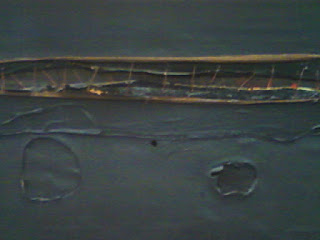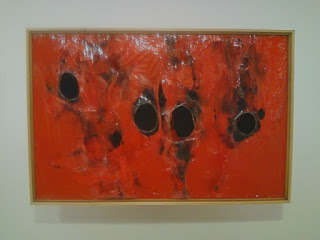Alberto Burri: The Trauma of Painting
Alberto Burri, an Italian artist recognized for having transformed the traditional easel painting into the Objet d'art (art object), was the subject of a large retrospective at the Guggenheim Museum entitled Alberto Burri: The Trauma of Painting which ended in January 2016. As a painter and sculptor, his experimentations laid the foundations for Process Art and the progressive Italian art form “Arte Povera”. The Sacchi (sacks) paintings, made from stitched and patched sections of torn burlap bags and often combined with pieces of abandoned clothing and paint bits, would cement Burri’s reputation worldwide during the second half of the Twentieth Century.
Born
in Citta di Castello, Italy on March 12, 1915, Burri was the son of a wine
merchant and an elementary school teacher. He earned his medical degree at the
University of Perugia. On October 12, 1940, Italy entered World War II and
Burri was sent to Libya as a medic in the Italian army. He would use his
surgical knowledge to treat the wounded soldiers mostly amputees and those
requiring skin grafts because of serious burns. May 8, 1943, his unit was
captured in Tunisia at the Battle of El Alamein and sent to a prison camp at
Gainesville, Texas for the remainder of the war.
 |
| Alberto Burri, Sacchi |
He learned to paint there through a local YMCA with donated materials and his first paintings, inspired by an Umbrian nostalgia, were views of the desert from camp. Italian prisoners had an easier life in contrast to German, and Japanese prisoners. For one thing, officers were exempt from manual labor and they were allowed to mix with the local Italian American community and engage in recreational activities such as building religious altars, playing soccer, and tend vegetable gardens. Italian detainee artists assigned repaint local church. After the war, Burri’s POW experience had a transformative effect as the young Italian doctor resigned from medicine on his return to Italy and pursue art. He endured the remonstrations from family and friends with a tranquil determination upon his arrival to the age-old city of Città di Castello, in Umbria.
Italy
was wrecked after the war as its resources were nearly depleted. The Fascist
years created a limited intellectual openness that left the nation worn and harsh.
Eventually however a modern Renaissance spread as the country was gaining self-assurance
in its future with the artists in the forefront. Art was used to reexamine Italian
history and future prospects. Painters, poets, and intellectuals formed new
groups and cultural associations publishing journals, encouraging new ideas, and
promoting a new philosophy for the arts.
During the 1950’s a cultural exchange began between Italy and the USA. American artists such as de Kooning, Rauschenberg, Rothko, Twombly visited and lived in Rome. The city was a meeting place for critics, most notably James Johnson Sweeney who became the second director of Guggenheim Museum and a champion for Burri by acquiring three art works for the museum’s collection. Johnson and Burri would share a lifelong friendship that entailed Burri sending Sweeney every year at Christmas a signed miniature of a work exactly proportioned to fit in the palm of a hand. Through this good fortune, Alberto Burri along with Lucio Fontana emerged as the pioneers of post-war Italian art.
Dada
and Surrealism were early influences on Burri’s work. The paintings by Arp and
Miro that incorporated burlap as a ground prompted Burri’s own use of torn red
stained burlap. Burri expressed a new aesthetic integrating stitching, burning,
wood, metal, plastic, tar, cellotex (insulation material used in homes), and
burlap that transformed the paintings from a mere pictures into objects. His
repertoire of work included the Sacchi (sacks), Catrami (tars), Muffe (molds),
Gobbi (hunchbacks made by metal protrusions placed behind the canvas), Bianchi
(whites), Legni (woods), Ferri (irons), Combustioni Plastiche (plastic
combustions), Cretti, and Cellotex works. Burri would often mix and match the
different materials and systems. The
clean fissures of his Crettis were never accidental but guided by a scientific
approach: he was a knowledgeable chemist. Using torches he created burrows in soft
gooey tar or burned holes through clear plastic and laid over a stained patched
surface. Scholarly opinion viewed them as symbolic of the
gore and broken skin that he encountered during the war.
 |
| Alberto Burri, Catrame 2, 1949 |











No comments:
Post a Comment